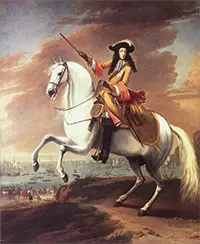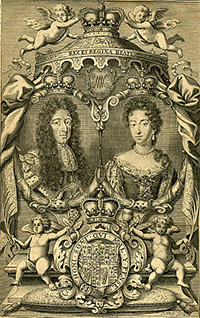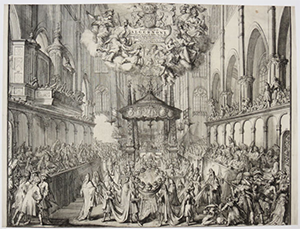William and Mary: Joint Monarchs of England
Part 2: Ruling Together
The royal couple were crowned King William III and Queen Mary II on April 11, 1689, in a lavish ceremony at Westminster Abbey. 
That wasn't the end of the line for James, however. He went to Ireland in March 1689 and, with French support, raised an army and then tried to regain his throne. King William led the English army against James's invasion and won the Battle of the Boyne, in July 1690. Forces sympathetic to James rose up in rebellion in Scotland as well, but they, too, were defeated. At this and other times, while William was away fighting, Mary ruled the realm herself, proving a strong and stable presence on the throne. At one point, she ordered her own uncle arrested for allegedly plotting to restore her father to the throne. Mary died of smallpox in 1694, proving that the deadly disease could cross any and all economic and political lines with impunity. She was buried at Mary and William had had three children, but none of them survived for very long after being born. Mary's sister Anne was by this time the heir apparent to the throne. When her only surviving son, Prince William, died in 1701, Parliament passed an Act of Settlement that stipulated that Anne's successor would be from the family of Sophie of Hanover–so a Protestant, rather than from the Catholic family of James II. The former king died in that same year. His son, also named James, became known as the "Old Pretender." 
Meanwhile, William had continued the Dutch war with France, which dated the Third Anglo-Dutch War in the 1670s. This conflict, known once William was King of England as the Nine Years War, finally ended in 1697. Not long afterward, England was involved in another European conflict, the War of the Spanish Succession. England and the Netherlands joined Austria in order to counter a French ruler on the Spanish throne. Spain's Charles II had died without a child to succeed him and had declared as his successor Philip, the grandson of France's King Louis XIV. England effectively sided with Austria's Habsburg claim to the Spanish throne over France's Bourbon claim. William, who had been heartbroken for years after the death of his wife, died in 1702, as a result of pneumonia that he contracted while recovering from a broken collarbone, an injury he sustained in a fall from his horse. His sister-in-law became Queen Anne. First page > The Background > Page 1, 2 |
|
Social Studies for Kids
copyright 2002–2025
David White



 It wasn't without political difficulty, however. The English Parliament had originally envisioned that Mary, as the daughter of the king, would rule and that her husband would be the king consort. William, as part of his agreement to engage in such a venture, insisted on being crowned king and co-equal with the queen. In exchange, the new monarchs agreed to ratify a new set of principles called the Declaration of Rights (later the Bill of Rights); among the things that they promised not to do was seek to collect taxes with the consent of Parliament. (This was a particular point of contention because previous monarchs had a habit of finding ways to avoid going through Parliament in order to get money from the people.) One key provision of the Declaration of Rights that was of paramount importance to England's Protestants was the prohibition of a Catholic's succeeding to the throne.
It wasn't without political difficulty, however. The English Parliament had originally envisioned that Mary, as the daughter of the king, would rule and that her husband would be the king consort. William, as part of his agreement to engage in such a venture, insisted on being crowned king and co-equal with the queen. In exchange, the new monarchs agreed to ratify a new set of principles called the Declaration of Rights (later the Bill of Rights); among the things that they promised not to do was seek to collect taxes with the consent of Parliament. (This was a particular point of contention because previous monarchs had a habit of finding ways to avoid going through Parliament in order to get money from the people.) One key provision of the Declaration of Rights that was of paramount importance to England's Protestants was the prohibition of a Catholic's succeeding to the throne. Westminster Abbey, during a service that many sources say was the first for any monarch of the realm that was attended by all Members of both houses of Parliament. The famed composer Henry Purcell wrote a special composition in her honor, and it was played at the service. One of her endowments was the College of William and Mary, in what is now Williamsburg, Va.
Westminster Abbey, during a service that many sources say was the first for any monarch of the realm that was attended by all Members of both houses of Parliament. The famed composer Henry Purcell wrote a special composition in her honor, and it was played at the service. One of her endowments was the College of William and Mary, in what is now Williamsburg, Va.
